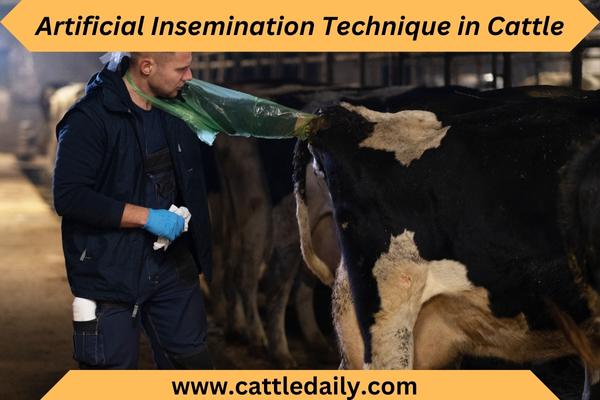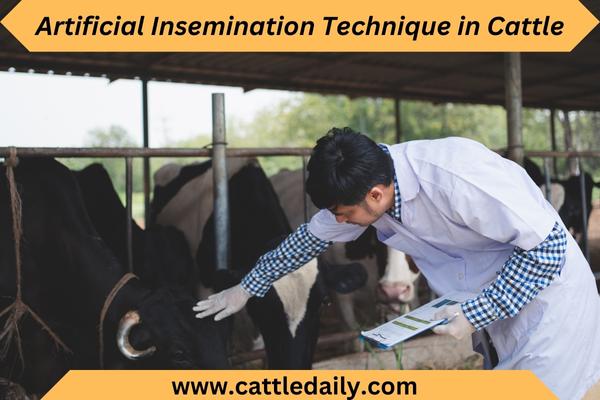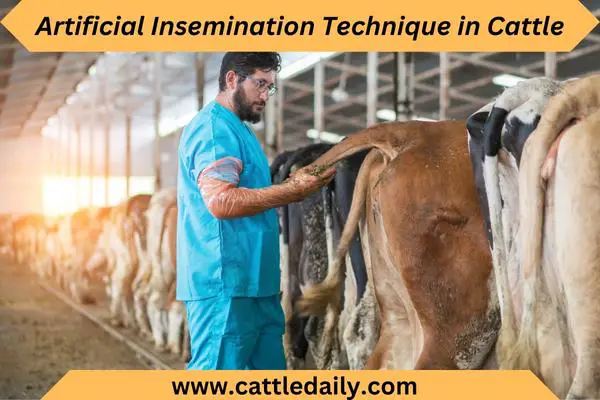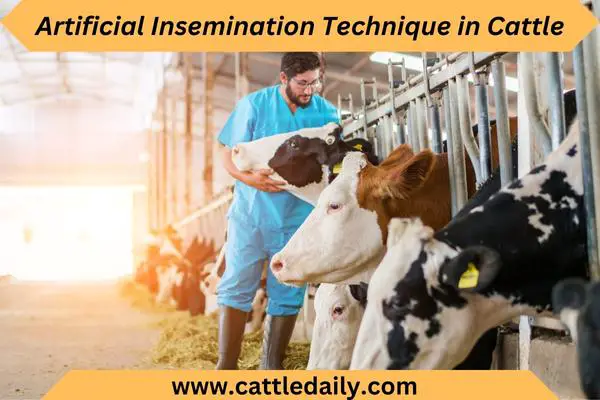Artificial Insemination Technique in Cattle
For centuries, cattle farmers depended on the natural mating of bulls and cows to produce calves. But since the 1940s, artificial insemination (AI) has revolutionized cattle reproduction.
This assisted breeding technology allows cattle producers to introduce desirable genetics into their herds quickly, efficiently, and safely.
AI provides cattle breeders with unprecedented control over selecting the traits they wish to propagate in their animals. With artificial insemination, a cow in Texas can be bred by a prized bull living halfway around the world. The powerful benefits of AI have made it the predominant breeding method in the global cattle industry today.
In this article, we will walk you through the critical steps cattle farmers need to follow to carry out artificial insemination successfully and achieve high conception rates in their herd.
From heat detection to post-insemination care, we will cover the key protocols and best practices for AI in cattle. Mastering these techniques is pivotal to reaping the full advantages of this transformative reproductive technology.
What is Artificial Insemination in Cattle?
Artificial insemination refers to the deliberate introduction of spermatozoa into the reproductive tract of female cattle using artificial means rather than natural mating.
The primary goal is to achieve fertilization by depositing semen containing fertile sperm as close as possible to the ovum inside the female cattle’s reproductive tract.
This assisted reproductive technology allows cattle producers to introduce desired genetics into their herds efficiently, avoid injury during natural mating of large animals, and prevent the transmission of sexually transmitted diseases between animals.

Benefits of Using Artificial Insemination in Cattle
Artificial insemination in cattle provides numerous benefits that have made it a widely adopted assisted reproductive technology in the cattle industry worldwide.
Obtains rapid genetic improvement by using semen from superior sires
AI allows cattle producers to impregnate their cows with semen collected from genetically superior bulls with traits like high milk production, disease resistance, calving ease etc. This quickly integrates favorable genetics into the herd which would take many generations of selective breeding to achieve.
Avoids injury during natural mating between large animals
Natural mating between large cattle weighing over 1000 pounds carries risks of injury to cows from the weight and thrusting of the heavy bull. AI eliminates this physical danger to animals during breeding.
Eliminates the costs of maintaining a bull
Keeping a bull is expensive, requiring year-round housing, feeding, health care, and handling precautions. With AI, there is no need for the costs and liability of having a mature bull onsite.
Decreases the spread of reproductive diseases
Sexually transmitted diseases can spread between cattle through uncontrolled natural mating. Using AI prevents the transmission of infectious reproductive diseases between animals via natural services.
Allows the use of semen from any bull in the world
Since AI uses collected semen, farmers have access to genetics from elite bulls across the globe without having to physically transport animals. This vastly expands genetic selection opportunities.
Results in conception rates over 65-70% in healthy females
Well-managed AI programs consistently report conception rates exceeding 65% in healthy cows. This is far higher than the 40-50% average conception rate for natural mating allowing greater selection intensity.
A cow can be bred by multiple bulls in one cycle
Unlike natural mating where the cow must be bred by the same bull repeatedly, AI allows breeding by multiple bulls within one cycle or heat period to generate a greater diversity of offspring from the cow.

Preparing for Artificial Insemination
Several key steps need to be taken to prepare the animals and equipment for the artificial insemination procedure.
1. Selecting a Sire
The first step is to select a high-quality bull whose genetics will contribute to your breeding goals. Consider traits like milk production, fertility, calving ease, etc. Semen can be purchased from bull studs that house and collect semen from elite bulls.
2. Heat Detection
Identify cows in heat using visual signs like restlessness, mounting, and secondary signs like reduced milk yield. The best time for insemination is 8-20 hours after the onset of heat. Accurate heat detection is crucial for AI success.
3. Semen Handling
Thaw frozen semen according to the manufacturer’s guidelines, usually by immersing in warm water. Prevent direct exposure to sunlight and handle gently to protect sperm cells. Use special artificial insemination guns to correctly place the straws.
4. Hygiene
Ensure the cow’s perineal area and equipment used are thoroughly cleaned and disinfected to prevent infection. Use disposable gloves and change them between cows.
Step-by-Step Artificial Insemination Procedure
With the cow restrained in a cattle crush, follow these steps:
1. Sanitize the cow’s vulva and surrounding area with mild soap and water or antiseptic spray. Use clean paper towels.
Proper sanitization of the vulva and perineum with a mild antiseptic solution helps prevent the introduction of infectious organisms during insemination which can lead to uterine infections and infertility.
2. Insert a clean gloved hand into the rectum to immobilize the cervix and guide the AI gun. Lubricate the hand and glove.
Rectal palpation of the reproductive tract is necessary to locate and stabilize the cervix during instrument insertion, while lubricant eases gentle manipulation and protects sensitive tissues.
3. Using the other hand, insert the loaded AI gun through the vaginal opening. Take care to not introduce contamination.
The AI gun is carefully guided through the vaginal canal into the cervix. Care must be taken to not pass exterior bacteria into the clean reproductive tract. The gun should be loaded with thawed semen.
4. Locate the cervical opening by feeling and manipulating the gun through the cervix into the uterus.
Identification of the cervical opening and passage of the gun through the cervix channels into the uterus requires skill via sensitive rectal palpation and manipulation through the reproductive tract.
5. Deposit the semen at the entrance of the uterine body. Slowly remove gun and hand from the reproductive tract.
Once correctly positioned, the plunger is depressed to release the semen at the opening of the uterine horns to achieve successful fertilization. Slow removal of equipment prevents injury while allowing semen deposition.

Post-Insemination Care
- Record cow ID and date of service for pregnancy checks later.
- Provide clean housing and monitor for signs of infection post-insemination.
- Don’t disturb the cow for 30-60 mins to allow semen deposition.
- Repeat insemination 12-24 hours later if heat persists to increase conception.
Confirming Pregnancy
Pregnancy can be confirmed by:
- Return to heat after 18-24 days if not pregnant
- Palpation of uterus after 30 days
- Ultrasound to detect heartbeat after 21 days
- Blood test for the pregnancy hormone after 21 days
Troubleshooting Low Conception Rates
If conception rates are low, review:
- Accuracy of heat detection
- Semen handling procedures
- AI gun handling technique
- Insemination timing
- Uterine infections or abnormalities
- Nutrition and health of cows
With proper management, artificial insemination can successfully integrate superior genetics into cattle herds for improved productivity and efficiency. Following the right protocols is key to achieving good conception rates.
Conclusion:
While requiring skill and diligence, artificial insemination gives cattle producers immense power to direct the genetic progress of their herds. This assisted breeding technique has propelled cattle reproduction into the modern era through its ability to swiftly multiply the genetics of elite animals.
When executed correctly, AI can achieve conception rates exceeding 65% in healthy cows – far higher than natural mating.
The future possibilities of artificial insemination in cattle are equally exciting, including integrating new reproductive biotechnologies. AI has clearly demonstrated its status as an indispensable tool for efficient cattle production. Learn here more about cattle reproduction tips and guides.

